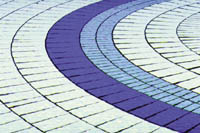
If there is a home remodeling project on the agenda, a visit to
a tile outlet might be a smart move.
If there is a home remodeling project on the agenda, a visit to a tile outlet might be a smart move.
The right tile properly installed can be used on floors, walls, countertops and ceilings, in places prone to water splashes and in boats and motorhomes.
In warm climates, tile is fine outdoors. In areas that freeze it can be used with weatherproof installation techniques. There are myriad colors, decorative styles and textures and sizes, ranging from tiny squares to slabs 2 by 4 feet or larger.
Its versatility has helped increase use of tile in the United States by more than 130 percent in the past decade.
While 2001 was a down year, tile consumption rose to 2.6 billion square feet by 2002, a 16 percent increase over the year before. The United States is now the fourth largest consumer of ceramic tile, after China, Spain and Brazil.
All this is hardly a recent discovery. Tiles in good condition have been found at Egyptian sites and buried under the ash at Pompeii, said Robert E. Daniels, executive director of the Tile Council of America. This survival is actually part of the tile mystique.
So what’s new about this ancient material? One recent innovation is the use of large porcelain tiles with the color all the way through. These often mimic marble, limestone, granite and slate. Advantages are that the tiles are lighter than stone and less expensive to install.
Decoratively speaking, mosaic tiles that form a picture, such as a wave pattern in a bath or shower or murals of fish and sea creatures in a swimming pool are popular, said Ann Sacks, founder of a design-oriented tile and bath fixture retail business.
Technology offers the ability to transfer virtually any image, including a photograph or logo, onto a tile surface. This has expanded use of tiles in commercial settings, such as restaurants and corporate offices.
This technology also can be used at home, said Paul Whitehill, owner of Images in Tile in Denver. The company will transfer anything from a famous artwork to a child’s drawing or a client’s photograph or logo onto ceramic tile. The tile is then cut and numbered and shipped to the client along with a template showing where each tile should be placed. “If a tile breaks, don’t worry. We supply duplicates,” said Whitehill.
For residential applications, even more appealing than photos or logos are custom reproductions of antique tiles. Solar Tile of New York will send any antique tile to Portugal to be copied in quantity in custom colors. The company is also one of a number selling antique tiles through its own showroom and a network of tile retailers around the country.
In the world of high-end design, antique tiles are considered very desirable. “Authenticity is important and period tiles are used in renovations and new construction of period style homes,” said Sacks.
Those who haven’t ventured into a well-stocked tile outlet recently may be amazed at the variety of samples on display. They run the gamut from reproductions of antique tiles from virtually any period to sprightly new designs reflecting current artistic and decorating trends.
Some of the most interesting tiles are handmade in small artisan workshops and studios. A renaissance of handmade tile production in the U.S. began in the 1980s. The artisans have been so successful that larger factories are now duplicating the handmade look.
Handmade tiles will always be more expensive since they take more labor and time and are made in smaller quantities. “But there is now a wide range of techniques to give a more handmade look, yet allow the tiles to be more affordable,” said Eric Astrachan, deputy director of the Tile Council of America. For example, the tile may be machine-made while the decoration is applied by hand.
During the course of the 20th century, one of the world’s oldest crafts became highly mechanized. At the same time, tile marketing has expanded globally – no more so than in the U.S., where nearly 75 percent of the tile used each year comes from another country, according to figures collected by the Tile Council. Lower costs make utilitarian foreign tile more competitive, but much of the decorative tile sold in the U.S. is actually made here, Astrachan said.
If you are setting tile yourself, tread carefully and make sure you know what you are doing. “The cost of a tear-out and replace is much higher than two times the original job cost,” said Daniels.









